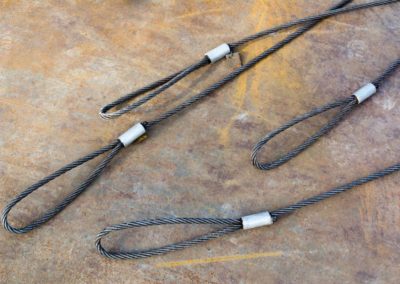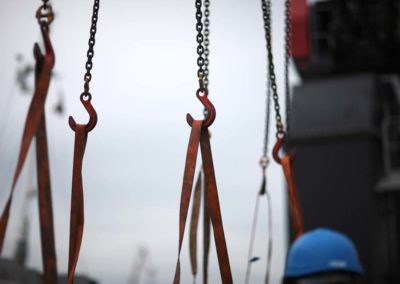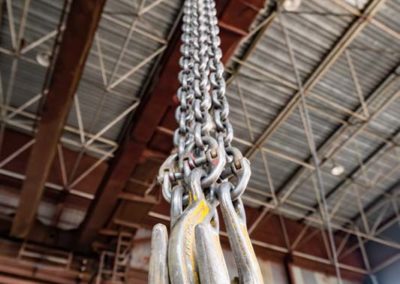Not all slings for material handling are created equal, and while a chain sling or wire rope sling may be an ideal fit for one application, it might prove disastrous in another. It is important to be familiar with the different categories and styles of slings so you can find the best and safest sling for your industrial material handling applications.
Types of Rigging and Lifting Slings
Rigging and lifting slings are used when there are loads to be moved. They are made from cable, chain, webbing, or rope and most often used with a crane. For heavy loads, steel products are preferred, but there are applications where polyester or nylon slings can provide the strength needed without the extra weight and stiffness of their metal counterparts.
Chain Slings
Chain lifting slings are used to handle odd-shaped, hard-to-position loads, or hot materials and they are known for being durable and rugged. The chains are available in different grades, where the higher the grade number of the chain the stronger it is; grades 80 and 100 are the most common. Note that chain slings are available in single, two leg, three leg, and four leg configurations.
Chain slings can be found in some of the most rugged environments, including steel mills, foundries and machine shops. They can handle loads that could cut or abrade other types of slings but tend to be more expensive and heavier. However, they are the most flexible in terms of their configurations. Chain slings do not stretch. Any observation of flexure or lengthening of the chain can be a sign of potential failure.
Wire Mesh Slings
When loads are too hot or too abrasive for web slings (such as you might find in the metalworking industry), wire mesh slings work well. They also work when loads have sharp edges that could damage other slings, or you need an additional bearing surface to balance the load. In addition, they have excellent flexibility with low stretch.
Wire mesh slings are usually made from alloy steel, carbon steel, or stainless steel, and they may be coated or impreg nated with elastomers or polymers. They can also be zinc-plated for improved corrosion resistance.
Wire Rope Slings
For rigging and lifting applications that require heavy-duty slings that are abrasion-resistant but still flexible, wire rope slings are the best option. And it does not hurt that they are typically the most economical option for the amount of load they can carry. The most common materials used in wire rope slings are EIPS (Extra Improved Plow Steel), FC (Fiber Core), and IWRC (Independent Wire Rope Core). More wires in the rope provide better flexibility while fewer wires provide better abrasion resistance. The most common choices for wire rope slings are either 6×19 or 6×37 class rope. The 6×19 option offers a good balance between flexibility and abrasion resistance while the 6×37 rope is more flexible but more susceptible to abrasion.
Wire rope slings are known for their ruggedness and durability, but they can be very heavy. And, they are susceptible to damage from kinking and crushing as well as abrasion. Their already long life can be extended by not bending them over sharp edges.
Polyester and Nylon Web Slings
Slings made from synthetic materials such as polyester and nylon are often referred to as web slings. When bulky objects are being lifted, balance and stability can be key– and for those applications, web slings (also known as cargo slings) are well adapted because they provide a wide bearing surface to support the load while also being relatively lightweight and highly flexible.
Polyester slings and nylon slings weigh much less than metal chain slings and wire rope slings. They are available in endless, flat, and round configuration and are available in models that can lift upward of 6,000 pounds. Most round slings are made from a continuous loop of polyester yarn and covered in a fabric that is color-coded based on lifting capacity.
Note that nylon works best for shock absorption while polyester is best for load control. Also, polyester slings can handle bleaching agents and common acids, but nylon cannot. Nylon can be used with grease, oils, alkalines, and aldehydes. Synthetic slings are also more susceptible to UV damage, cuts, tears, and abrasions than their metal counterparts.
Styles of Slings
There are also various styles of slings, including the following:
- Eye slings, which can be used in a choker, vertical, or basket hitch; variations include attached wide eye and twisted wide eye
- Reverse eye slings, where eyes stand open at 90° to the sling body to allow for easier basket and chocker hitches
- Endless slings, which takes the form of a loop for synthetic slings but also available for chain slings
- Triangle slings, have a steel triangle at each end and can be used with vertical or basket hitches
- Triangle choker slings, similar to a triangle but can also be used with choker hitchers
- Bridle slings, which allow for multiple pulls at the same time so that loads can be distributed more evenly
Sling Configurations
In addition to types and styles of slings, there are also sling configurations that describe how chain, wire mesh, and wire rope slings can used to lift the load. The two main categories are: one-leg slings and multi-leg slings.
One-Leg Slings
One-leg slings are divided into three different categories: choker, vertical, and basket hitches. A choker hitch wraps around the load and is ideal for irregular or unbalanced loads that consist of thin objects. A vertical hitch is the most common sling configuration and attaches to the load via a hook. The basket hitch has the highest capacity and offers more stability and load distribution.
Multi-Leg Slings
Multi-leg slings provide more control and stability than one-leg slings. The lift angle (angle formed by the legs as they wrap around the load) determines the load capacity. The three basic angles, in order of load capacity, are 30°, 45°, and 60°. Using an angle of less than 30° is not recommended and 30° should only be used when there is limited clearance.
Conclusion
Combining the right type of sling with the most appropriate style helps to ensure the safety of the load and any nearby personnel and equipment. If you are interested in purchasing an appropriate lifting sling for your application, Hi-Speed Industrial Service can help you navigate the often-complex world of sling types, styles, and configurations. Contact Hi-Speed today!




